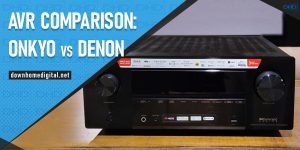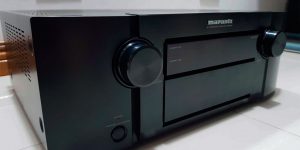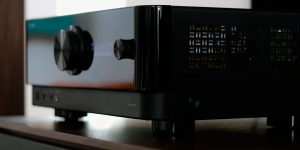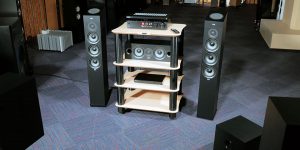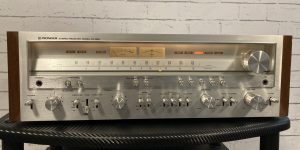The history of the Marantz brand began in 1953 when Saul Marantz decided to create equipment that could please audiophiles from all over the world with detailed and clear sound. The company’s first office was arranged in his basement, which is rather symbolic considering how popular this brand is nowadays.
The market of gear targeted at people with high demands concerning sounding is developing very fast. Still, the number of buyers searching for the best Marantz receiver proves the undeniable excellence of this manufacturer. The company tries to cater to the needs of all categories of consumers. In other words, you can find feature-packed receivers with a mind-boggling price tag, more budget-friendly models, designed for remarkable stereo experience, and purpose-built units for creating cinema-inspired environments.
People opt for Marantz receivers because of their sound quality, which remains on point no matter what music genre you listen to. This is confirmed by numerous Marantz receiver reviews concerning exactly the sound quality. Though other brands work hard to achieve this encompassing sound effect, few actually manage to. Another important factor is durability because these receivers are designed to work flawlessly for many years. Last but not least is a wide set of different functions that will simplify interaction with the receiver, as well as support most modern technologies and standards.
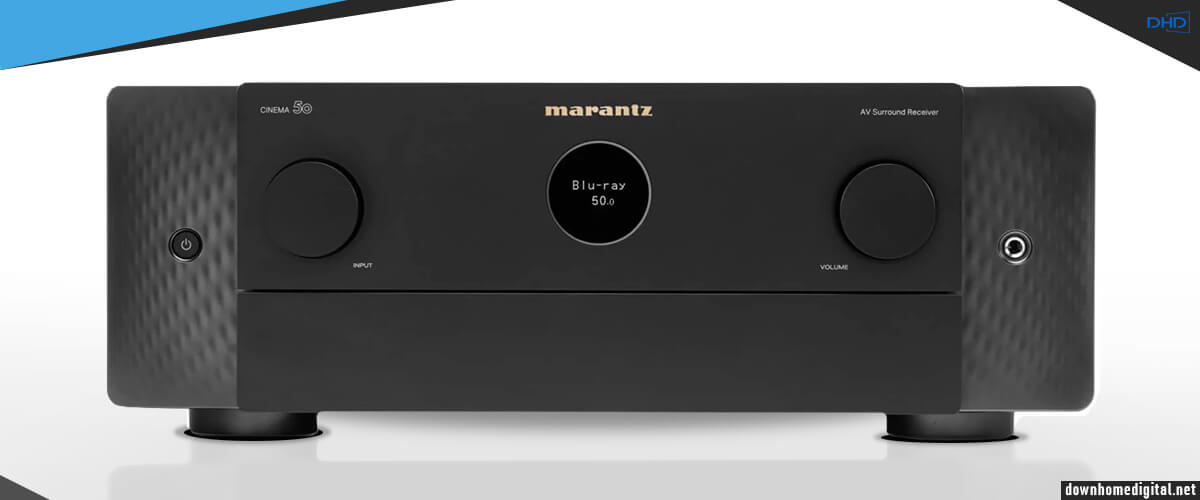
Marantz receivers comparison table
| Name | Channels | Power output | HDMI in/out | Bluetooth/Wi-Fi | Review |
|---|---|---|---|---|---|
| Marantz CINEMA 50 best overall | 9.4 | 110W/8 Ohm, 150W/6 Ohm | 6/3 | yes/yes | Review |
| Marantz SR8015 premium | 11.2 | 140W/8 Ohm, 175W/6 Ohm | 8/3 | yes/yes | Review |
| Marantz SR5015 under $1000 | 7.2 | 100W/8 Ohm, 140W/6 Ohm | 6/2 | yes/yes | Review |
| Marantz NR1510 budget and slim | 5.2 | 50W/8 Ohm, 60W/6 Ohm | 6/1 | yes/yes | Review |
| Marantz NR1200 stereo | 2.0 | 75W/8 Ohm, 100W/6 Ohm | 5/1 | yes/yes | Review |
Which receiver to choose: stereo or multichannel

While building a home sound system, you need to use a receiver to make it show its full potential. In general, there are two types of receivers (home theater and stereo) that are created to serve slightly different purposes. Have a look at the table below to grasp what units can level up your movie experience and what models are fit for music consumption only.
Home theater pros & cons
Advantages of home theater receivers
- 5+ channels.
- Full surround sound support.
- Rich set of video inputs.
- Allows for numerous configuration.
Disadvantages of home theater receivers
- Troublesome setup.
- Can’t provide absolute sound fidelity.
Stereo receiver pros & cons
Strength of stereo receivers
- Music-focused design.
- Unmatched sounding capabilities.
- Has high-fidelity audio inputs.
- Intuitive setup.
Weakness of stereo receivers
- Only two channels.
- A poor set of video inputs (or none at all).
An AV receiver is a go-to option if you need a central hub for connecting all audio and video sources in order to create a home theater system in your house. A stereo receiver is mainly focused on boosting your listening experience by combining all audio sources into one whole.
Marantz AV receivers have 5 amplifiers and 1 subwoofer preamp output as a minimum. However, in recent years, the brand has shifted focus on creating more powerful amplifier models capable of driving 7+ speakers. Another specific feature of an AV receiver is support for surround sound formats. Top-tier devices can decode several formats at a time, offer multi-zone connection and control, provide wireless connectivity and access to voice assistants.
When it comes to a stereo receiver, it can handle only a 2-channel speaker configuration, which is actually enough for its major goal – to deliver a great listening experience. In addition, such a unit has only analog audio connections, while surround sound processing is absent.
In general, both types of receivers can nicely diversify your home entertainment but in a different way. If you are solely interested in listening to music, spending money on an AV receiver with advanced video features makes no sense. In case you frequently organize movie nights and want a device with equally good audio and video capabilities, an AV receiver is a sure way to go.
Difference between budget and premium Marantz AV receivers

When shopping for the best Marantz receivers, I came across decent options both in affordable and premium segments. Anyway, I was curious about the reason for such price gaps and whether it is possible to purchase a good device without getting stony broken.
Most buyers usually rephrase the question this way – “Do expensive AV receivers produce a better sound than cheap models?” Frankly speaking, they are, but many factors affect the resulting sound.
For you to understand the topic better without delving into the world of technical stuff, I recommend paying attention to the main components of an AV receiver that can raise the cost.
Wired & wireless inputs
More expensive receivers have a broader range of wired and wireless inputs. To stay on the safe side, you need to define how many devices you are going to connect to your receiver. Anyway, it is always better to have at least one extra input for the future.
Design
This actually refers to the body of a receiver. Those belonging to a premium group have more durable chassis and fancier styling. They are fitted with an advanced ventilation system and vibration-resistant elements.
Digital to analog conversion
Signals that come via wireless and wired inputs have to be converted for your receiver to “understand” them. This is an important stage, which largely affects the actual output. A top-of-the-range Marantz AVR has a better DAC chip than its budget-friendly counterparts.
Amplifiers
High-priced receivers are fitted with powerful amplifiers, so the sound you hear is detailed and dynamic, corresponding to how a real immersive experience should feel. When it comes to cheaper models, manufacturers have to use less profound and durable amplifiers to reduce the total cost.
DSP component
When selecting an AV receiver, you probably want it to decode all popular surround sound formats. However, such a feature comes at a price. The higher it gets, the more formats your receiver can process.
Calibration mechanism
To streamline the setup process, advanced receivers come with an auto-calibration feature. Of course, you need to pay extra for this option.
How I picked and tested Marantz receivers
My search for the best Marantz receiver was very interesting as I tested all the models in my studio, which resembles standard environments where people usually arrange such systems. Thus, I got down-to-earth results, which will be relevant for most users.
To evaluate the surround sound effects in the video, I watched John Wick: Chapter 3 – Parabellum.
In order to determine how well these devices cope with audio, I listened to different songs. I also switched from numerous streaming platforms to provide an unbiased opinion.
- Led Zeppelin – Ramble On –Spotify
- Jacky Terrasson – Reach – Tidal
- The Weeknd – The Hills – Deezer
- Bob Marley & The Wailers – Turn Your Lights Down Low – (CD player)
- Radiohead – The National Anthem – (CD player)
- Arctic Monkeys – Do I Wanna Know – (CD player)
- Mark Nauseef – With Space in Mind (CD player)
- Mahler – Symphony No.2 (CD player)
The set of my equipment consists of:
- CD player SACD 30n
- Blu-ray player Sony UBP-X700
- Speaker wire – AudioQuest Type-9
- Speakers for movie – Klipsch RP-8060FA
- Stereo speakers:
- Klipsch RP-8060FA
- KEF Q350
- DALI OBERON 5
- Bowers & Wilkins 703 S2
Best Marantz receivers reviews
Marantz CINEMA 50 – best overall

Released in 2022, the Marantz CINEMA 50 essentially displaces the Marantz SR6015 and Marantz SR7015 from the brand’s lineup, as it’s an averaged improved likeness of both. By the way, you can find them in the Discontinued section at the end of my review; they are still available for sale. All three models are 9-channel receivers expandable (using an external amplifier) to 11 channels, but with the CINEMA 50, you can add 4 subs, which, in my opinion, is an advantage. In general, I wanted to say that the balance of cost, quality, functionality, and features of this AVR allowed me to put it on the podium, awarding it the winner’s gold medal.
As for the design of the receiver in question, it is standard for the CINEMA lineup, where everything is perfect except for the ridiculously small round and dim display. I realize this is not the most important detail, and my opinion is extremely subjective, but I am an old-school follower. I need to see what the receiver understood from what I ordered it to do. Ok, we’re dealing with a modern device here, and with an app that offers extensive customization and control of the system, you may not be looking at an on-screen menu or LCD at all, but if it’s there, then it’s there for something. Otherwise, I have no complaints about the design. The model is representative of the premium rank, and I couldn’t find anything to pick on even if I looked hard. You’ll find gold-plated RCA Terminals, and the weight of the design speaks to the use of high-quality components (29.8 pounds). But unlike the premium Marantz SR8015, the CINEMA 50 does not have a copper-plated chassis.
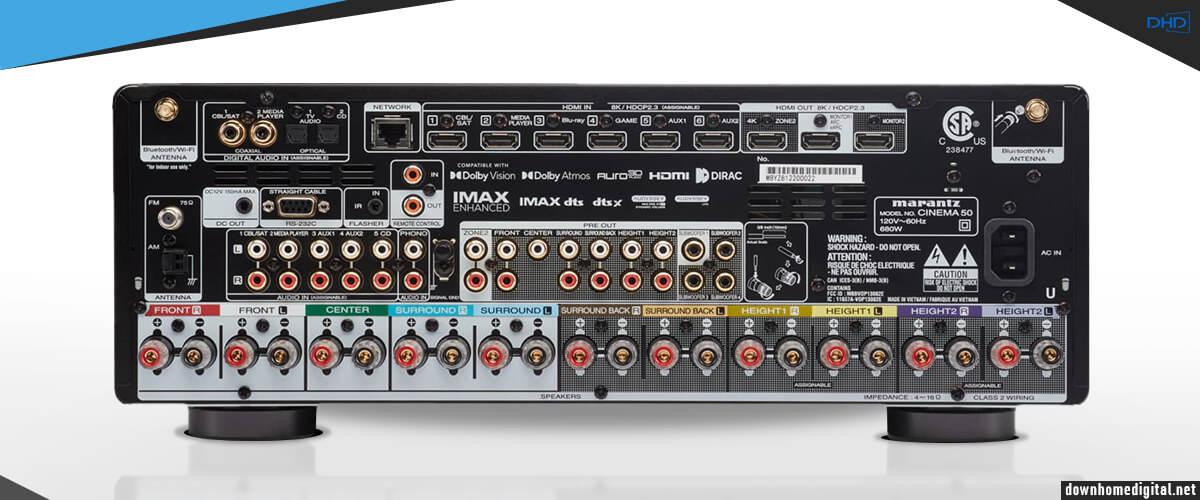
If we continue to compare our receiver to the premium model in the 2nd place of my selection, there are a few things to be said. First, the CINEMA 50 has less power at 110 watts (8 ohms, 20Hz-20kHz, 0.08% 2ch) versus 140 watts. Also, the model in question has fewer HDMI ports (6 inputs vs. 8 inputs), but they all have version 2.1 (passes 8K video on all inputs and outputs). But if you’re a fan of older equipment, you’ll have nowhere to plug it in (no composite and component jacks) because we’re dealing with an extremely modern device designed only for the latest equipment.
You’ve probably guessed that the latest Marantz line was created for the most comfortable home theater experience. It’s obvious from the name. That’s why I always enjoy testing the CINEMA models. So I fired up Day Shift on Netflix and got to testing. So, my first impression is that the receiver lacks power. No, don’t get me wrong, everything is fine; the immersive effect, the dispersion, and the quality level of the sound waves (I use a lot of equipment in the studio) are all very high. But for an 11-channel system, I’m used to literally feeling the bass. I think that’s what having the option of 4 independent subs is related to; they do their job. But without them, the picture is not as rich. Nevertheless, Marantz uses technologies such as Current Feedback Topology and HDAM in their premium models, with which Dolby Atmos and DTS:X feel great. And don’t neglect the 360 Reality Audio feature; with it, you don’t have to use ceiling speakers (good for virtual immersive formats).

I also used external sources, and I’d like to point out that the 1080P/4K upscaling function works to 8K. Rarely does it work properly, especially on old DVDs that I cannot throw away (I justify this fact with my work, and keeping it in the studio saves me from my wife’s leering eyes). So, I can’t say everything is perfect, but if you compare it with cheaper or older models, even from Marantz – it’s great. Rare instances of pixels showing up happen, but overall, I was pleased, which is rare regarding zooming.
Despite my and your emphasis on movie viewing, the CINEMA 50 was also excellent in music. Stereo from CDs or streaming services sounds layered and detailed. And because I’m an audiophile, I gave it a challenge with Pink Floyd and symphony orchestras. Marantz’s lovely, warm echo gives the music a life-like realism when the musician’s fingers touch the keys or strings.
It has become somewhat of a tradition that I sometimes recommend certain models of speakers for particular receivers. This time, a pair of Bowers & Wilkins 703 S2 front speakers impressed me the most. I hope those of you who intend to buy the rather expensive CINEMA 50 will be prepared to splurge on good speakers, too, realizing how important the combination of these components is. The receiver processes and produces sound, but with simple speakers, you won’t hear what the AVR can. The Bowers & Wilkins 703 S2s own studio technology, and their 1-inch tweeters and 6-inch woofers bring out every detail of the piece. Sound ranges don’t overlap, and you get layering but not blending of separate soundtracks as if you were directly in front of the performers. It’s just brilliant.
To summarize all of the above, the Marantz CINEMA 50 is a mega-modern 9-channel receiver of the highest class with support for the most popular surround sound and video formats (8K, upscaling, CEC, HDCP 2.3, eARC, and gamer features). Its design utilizes components and technologies that create a great sound picture in immersive formats and stereo. This is the best Marantz receiver you can buy today at a reasonable price for its level while expanding the system to 11 channels or using it to broadcast video and audio to 2 zones.
It’s not too powerful among other models, but you can compensate for that with 4 independent subs. And you won’t be able to connect old equipment to it (many people now think, “Why connect it at all?”). But the main thing to keep in mind is that you get guaranteed longevity as the center of your home theater.
| Power |
|
| HDMI features |
|
| Video features |
|
| Network |
|
| Surround sound processing |
|
Pros
- Optimal price/quality/functionality ratio.
- The CINEMA 50 system can be expanded up to 11 channels.
- Unlike other 9-channel receivers, this one can connect 4 subwoofers.
- The app offers extensive customization and system control options.
- All HDMI ports support 8K video and HDCP 2.3 protection.
- The 1080P/4K upscaling function to 8K works great.
- Marantz Current Feedback Topology and HDAM help create incredible audio quality.
Cons
- No inputs for older equipment.
- Not powerful enough for an 11-channel system.
Marantz SR8015 – premium
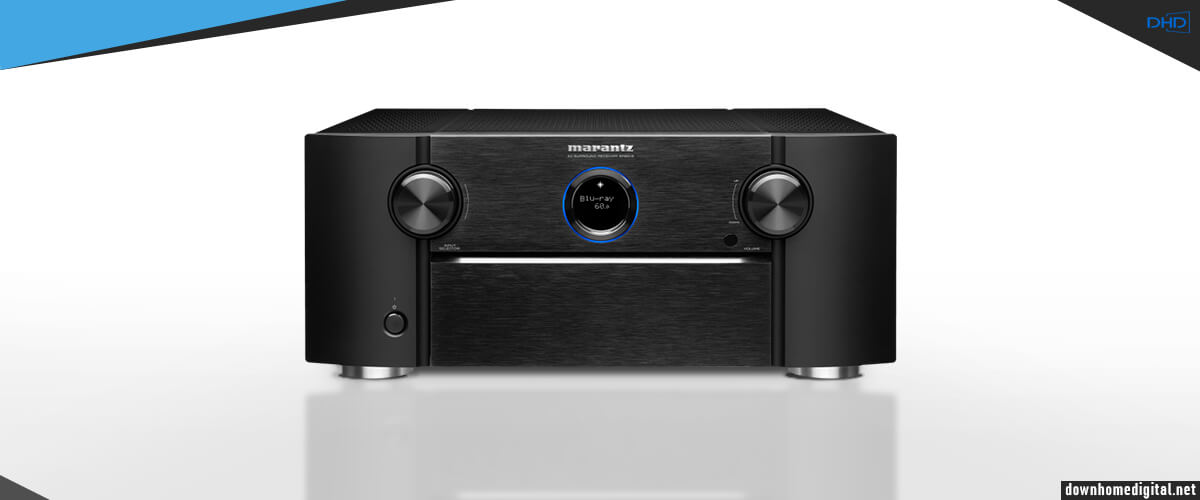
Marantz SR8015 is a powerful 11.2-channel receiver capable of decoding any modern AV format. It has impressive functionality and was developed on the basis of cutting-edge technologies. The manufacturer installed 11 power amplifiers with a total output of 140 watts per channel at 8 Ohms and 175 watts at 8 Ohms for lively and powerful sound. And guess what? You can expand the system to 13 channels and pay the same price today for this premium Marantz AV receiver as you would for a selection leader. Wow? But it’s not that simple. Along with some pros, there are always cons if the price is undervalued. Let’s go; I’ll tell you everything (well, ok, almost everything, study the specifications).
The SR8015 does not have the elegance and lightness of the CINEMA 50. It resembles a grandmother’s trunk filled with various “treasures,” and in fact, it is. The large, rectangular, somewhat simple, and very heavy (38.4 lbs.) receiver has an incredible number of connections, gold-plated RCA connectors, a copper-plated chassis, and the stuffing worthy of a real movie theater. Don’t forget that this is a 2020 premium model you might not have considered 2 years ago because of the very high price tag. Like the CINEMA 50, there’s room for Current Feedback Topology and HDAM, but also a Toroidal Transformer, Discrete Power Amplifier, Clock Jitter Reducer, and MDAX2. If those names don’t tell you anything, just take my word that for decades to come, the SR8015 will perform at exactly the same level of audio signal quality as the day you install it in the center of your system. All external controls are hidden under a metal cover on the front of the chassis. There is also a normal LCD, on which, unlike the decorative round one, you can easily see everything.
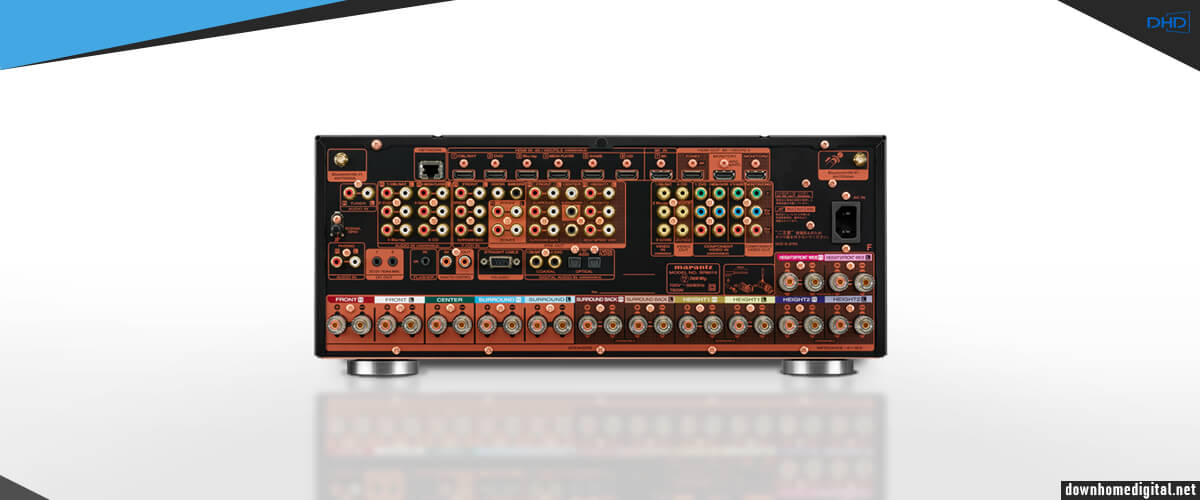
The range of supported formats is awe-inspiring. The most popular are Dolby Atmos, Auro-3D, and DTS:X. As for video capabilities, this device supports HDR10/10+ and Dolby Visions, so you can watch your favorite content in great quality. Besides, thanks to full-featured HDMI 2.1, this receiver will become the centerpiece of your home theater system.
In addition to wired inputs (8 HDMI inputs and 3 outputs, digital connectors, and MM phono input) this receiver allows streaming content wirelessly. The SR8015 can be integrated into the flexible HEOS multi-room system, which extends the number of operations you can do wirelessly. Using a dedicated HEOS app, I controlled the receiver, adjusted playback parameters, launched streaming services (Spotify, Deezer, etc.), and arranged compositions.
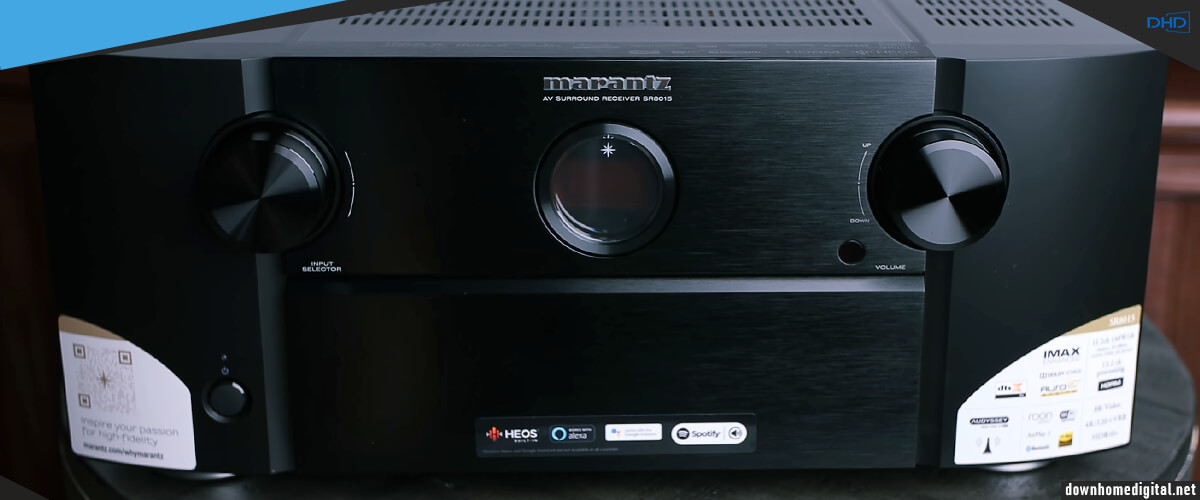
Perhaps it is worth describing that at maximum power; it is worth watching movies like the Batman series with Christian Bale and the now eternal Heath Ledger. Not to go into a countless enumeration of the sound effects I observed on my equipment in the studio, I’ll just say that you could literally feel not only the blast wave but even the flapping of the main character’s wings. The Joker’s extraordinary warped voice gave me goosebumps, even though I’ve seen The Dark Knight many times. All in all, you want a real movie theater at home – this is it. Even scenes in an ordinary environment, like dialogues in a restaurant, create an incredibly real picture, like servers and customers moving right behind your back, clinking glasses, and rustling tablecloths.
If I were to compare receivers to cars, I might describe the Marantz SR8015 as an old-model Ferrari. I think you can imagine the square design of the car and some outdated features, but what’s under the hood will never go out of production. Just never.
The model only has 1 HDMI input that supports 8K video. The UI menu system needs an upgrade, but it’s a powerful monster ready to take you into the space of any movie, immersing you in the heart of the action. Something not too old, once costing a few thousand dollars, today can truly please someone who does not chase fashion conformity but understands power and deep sound quality. This is the reason why I gave it only the second place in the rating.
| Power |
|
| HDMI features |
|
| Video features |
|
| Network |
|
| Surround sound processing |
|
| Channels | 11.2 |
| Stereo power (RMS), W/Ohm | 140/8, 175/6 |
| Output impedance, Ohm | 8, 6 |
| Frequency response | 10Hz-100KHz |
| THD in stereo, % | 0.05 |
| Digital to analog converter (DAC) | N/A |
| Bi-amping | yes |
| Pure direct (straight) | yes |
| Auto speaker calibration | Audyssey MultEQ XT32 |
| Speaker A/B switching | yes |
| Other audio features | Audyssey Dynamic Volume, Audyssey Dynamic EQ, Audyssey LF, Compressed Audio Enhancer(MDAX2), Hi-Res audio |
| Wi-Fi | 2.4/5GHz |
| USB | 1 (USB 2.0) |
| Bluetooth | yes |
| Ethernet (RJ45) | 1 |
| DLNA | yes |
| MHL | no |
| Apple Music (AirPlay) | AirPlay, AirPlay 2 |
| Amazon Music | yes |
| Spotify | yes |
| Other streaming services | Deezer, TIDAL, Pandora, SiriusXM, Napster, SoundCloud |
| HDMI input/output | 8/3 |
| HDMI ARC (Audio Return Channel) | yes |
| HDMI eARC (Enhanced Audio Return Channel) | yes |
| HDMI CEC | yes |
| Digital content protection (HDCP) | HDCP 2.3 |
| Subwoofer output (LFE) | 2 |
| Headphone output | 1 x 6.3 |
| Optical digital input | 2 |
| Coaxial digital input | 2 |
| Composite input | 5 |
| Component input/output | 3/1 |
| Phono (MM) input | yes |
| Front panel connectors | USB, HDMI, phones, setup mic, AUX |
| Multi channel preamp output | yes |
| HDR (High Dynamic Range) | HDR10 |
| 4K signal pass-through | 4K/120Hz |
| 8K signal pass-through | 8K/60Hz |
| HDMI signal pass-through | yes |
| 3D signal pass-through | yes |
| HDMI pass-through in standby mode | yes |
| Video conversion | analog to HDMI |
| Analog to HDMI scaling | yes |
| HDMI to HDMI scaling | yes |
| Dolby Vision | yes |
| Other video features | HLG, BT.2020, Dynamic HDR |
| Voice control | Amazon Alexa, Google Assistant, Siri, Josh.AI |
| App control | iPhone, iPad, iPod, Android |
| Display | colour OSD |
| Tuner | AM, FM |
| Sleep timer | yes |
| Auto power off | yes |
| ECO mode | yes |
| Graphical user interface (GUI) | yes |
| Setup assistant | yes |
| Firmware update | network, USB |
| Other additional features | IP Control, Web Control, RS-232 Control, App Control |
| Multi-room zones | 3 |
| Zone audio output | speaker, preout |
| Zone HDMI output | yes |
| Multi-room control | Marantz 2016 AVR Remote, HEOS App |
| RS-232 | 1 |
| Remote control input/output (IR) | 1/1 |
| DC trigger output (12V) | 2 |
| Dolby Atmos | yes |
| Dolby TrueHD | yes |
| Dolby Surround | yes |
| Dolby (other) | Dolby Digital Plus, Dolby Atmos Height Virtualization |
| DTS:X | yes |
| DTS HD Master | yes |
| DTS Virtual:X | yes |
| DTS Neural:X | yes |
| DTS (other) | DTS 96/24, DTS-HD, DTS-EXPRESS |
| Auro-3D | yes |
| IMAX Enhanced | yes |
| Multichannel stereo | yes |
| MP3 | yes |
| WMA | yes |
| AAC | yes |
| WAV | yes |
| FLAC | yes |
| ALAC | yes |
| Other audio file formats | AIFF, DSD |
| Operational power consumption, W | 780 |
| Standby consumption, W | 0.1 |
| Removable power cord | yes |
| Size W x H x D, cm/inches | 43.1 x 17.7 x 43.1/17.3 x 7.3 x 17.7 |
| Weight, kg/lbs | 17.2/38.4 |
| Release year | 2020 |
Pros
- The system can be expanded up to 13 channels.
- Incredibly rugged construction with premium components and technology.
- The highest power rating is 140 watts.
- Has a huge variety of old and new connections.
Cons
- Only 1 HDMI input supports 8K video.
- The user interface menu system needs to be upgraded.
Marantz SR5015 – under $1000

If you are not satisfied with the cost of the previous two models and want an alternative to the leader of the selection at half the price, then Marantz SR5015 may meet your requirements. It combines the advantages and disadvantages of the receivers mentioned above, but since it is a 7.2-channel AV receiver, you should expect a lot of compromises. Nevertheless, the device can work with one of the most popular 3D sound formats, namely DTS:X. Yes, I’m not mistaken; SR5015 does not support Dolby Atmos (a 2019 model, after all).
The receiver under review belongs to the old leading line of Marantz, so the receiver’s design is extremely simple. The front panel buttons represent external controls, but I like them much better than the round ones on the CINEMA, as they are brought slightly forward, and I don’t bang the cabinet while pressing them. Obsolete or not, the SR5015 is decently made; its controls are smooth, and the buttons are very pleasant to press (no clicking, effort, or skipping). The remote is outdated too, of course, but it’s easy to use, unlike modern ones. The volume control with it is not clear. I would say it is a good workhorse with the quality of the middle segment, which has moved to the budget segment (but still at the top of the latter). But it should be expected that it lacks the glamor of premium models. Everything looks and feels a bit simpler, although you can’t call it cheap.
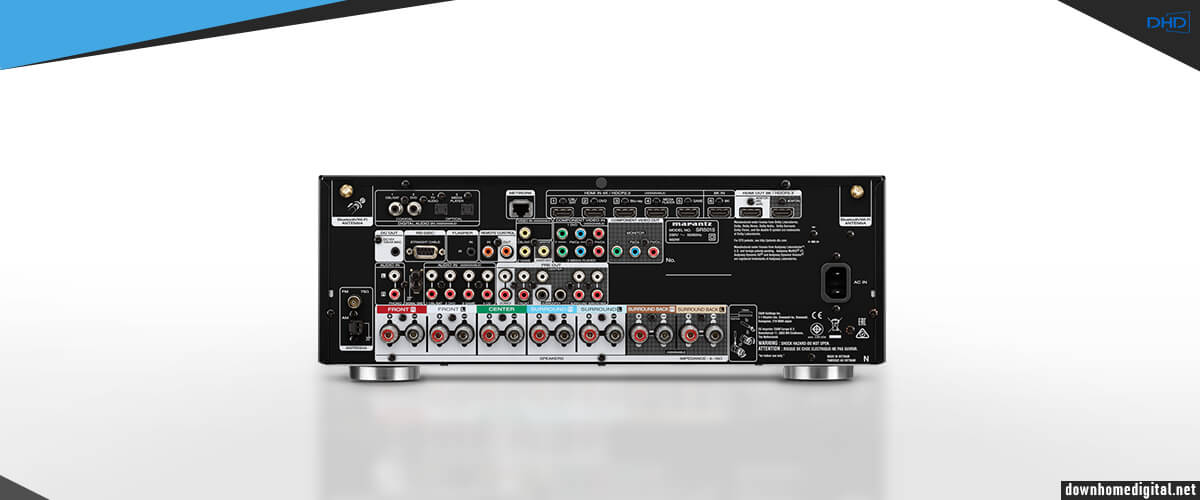
The developers have embodied the company’s philosophy in this receiver – music should sound exactly as the performers intended, with expression, mood, and emotions. The receiver helps reproduce soundtracks, effects, and music in films exactly as they were recorded in a studio. The power output reaches 100W when paired with 8 Ohm speakers and 140W/6 Ohms.
What I liked most is that the SR5015 comes with a special technology that mimics the sound you get when you add ceiling speakers to the setup. I didn’t use such speakers during tests, but I felt like I was in the sound dome while watching the movie. It seemed that shooting took place right above my head.
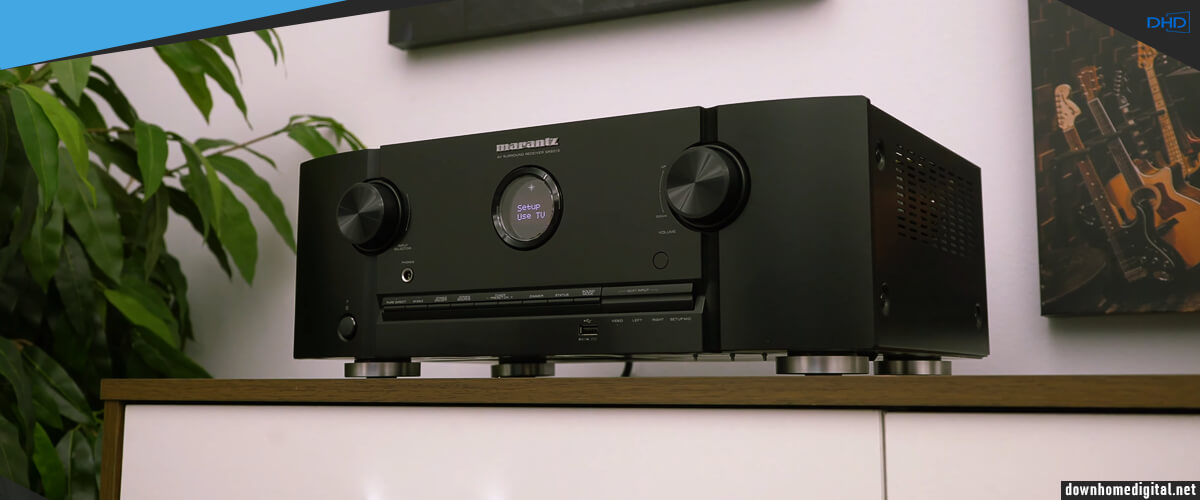
The receiver has an eARC feature, so you can transfer all audio information without the slightest loss through a single HDMI cable. This applies to the object-oriented formats , which means you can enjoy surround sound in all its glory while keeping the other HDMI ports free. Connectors of this type are sufficient for a small system. There are 6/2 of them here. But only 1 of the inputs is for 8K video (just like the premium but aging SR8015; still, they are from the same series, which CINEMA is gradually replacing).
While listening to music, I got the legendary Marantz signature sound. It is particularly smooth, natural, and crisp. The sound at high frequencies is very clear, without the slightest crackles and rattles, the mids are especially rich, and the bass is powerful and deep. Moreover, the sound quality doesn’t change depending on the source, be it music, video games, soundtracks of films, radio, streaming audio, and more.
So, here we have a 7-channel model, which will soon go out of circulation as Marantz has more modern (but also more expensive) alternatives. But if I were looking for a top Marantz receiver under $1000, my choice is unambiguous. Innovative HDAM modules, support for the highest quality DTS:X surround sound format, built-in Wi-Fi, streaming services, 4K resolution with HDR (8K on a single HDMI input), multi-room streaming with HEOS – these and other features make SR5015 a great solution for high-end audio connoisseurs. If you are one of them, don’t hesitate to buy this model.
| Power |
|
| HDMI features |
|
| Video features |
|
| Network |
|
| Surround sound processing |
|
| Channels | 7.2 |
| Stereo power (RMS), W/Ohm | 100/8, 180/6 |
| Output impedance, Ohm | 8, 6 |
| Frequency response | 10Hz-100KHz |
| THD in stereo, % | 0.08 |
| Digital to analog converter (DAC) | AK4458 384 KHz/32-bit |
| Bi-amping | yes |
| Pure direct (straight) | yes |
| Auto speaker calibration | Audyssey MultEQ XT |
| Speaker A/B switching | yes |
| Other audio features | Audyssey Dynamic Volume, Audyssey Dynamic EQ, Compressed Audio Enhancer(MDAX2), Hi-Res audio |
| Wi-Fi | 2.4/5GHz |
| USB | 1 (USB 2.0) |
| Bluetooth | yes |
| Ethernet (RJ45) | 1 |
| DLNA | no |
| MHL | no |
| Apple Music (AirPlay) | AirPlay, AirPlay 2 |
| Amazon Music | yes |
| Spotify | yes |
| Other streaming services | Deezer, TIDAL, Pandora, Napster, TuneIn Radio, iHeart Radio |
| HDMI input/output | 8/2 |
| HDMI ARC (Audio Return Channel) | yes |
| HDMI eARC (Enhanced Audio Return Channel) | yes |
| HDMI CEC | yes |
| Digital content protection (HDCP) | HDCP 2.3 |
| Subwoofer output (LFE) | 2 |
| Headphone output | 1 x 6.3 |
| Optical digital input | 2 |
| Coaxial digital input | 2 |
| Composite input | 2 |
| Component input/output | 2/1 |
| Phono (MM) input | yes |
| Front panel connectors | USB, HDMI, phones |
| Multi channel preamp output | yes |
| HDR (High Dynamic Range) | HDR10 |
| 4K signal pass-through | 4K/60Hz |
| 8K signal pass-through | no |
| HDMI signal pass-through | yes |
| 3D signal pass-through | yes |
| HDMI pass-through in standby mode | yes |
| Video conversion | analog to HDMI |
| Analog to HDMI scaling | yes |
| HDMI to HDMI scaling | yes |
| Dolby Vision | yes |
| Other video features | HLG, BT.2020 |
| Voice control | Amazon Alexa, Google Assistant, Siri, Josh.AI |
| App control | iPhone, iPad, iPod, Android, Amazon Kindle |
| Display | colour OSD |
| Tuner | AM, FM |
| Sleep timer | yes |
| Auto power off | yes |
| ECO mode | yes |
| Graphical user interface (GUI) | yes |
| Setup assistant | yes |
| Firmware update | network, USB |
| Other additional features | IP Control, Web Control |
| Multi-room zones | 2 |
| Zone audio output | speaker, preout |
| Zone HDMI output | no |
| Multi-room control | Marantz AVR Remote App, HEOS App |
| RS-232 | 1 |
| Remote control input/output (IR) | 1/0 |
| DC trigger output (12V) | 1 |
| Dolby Atmos | yes |
| Dolby TrueHD | yes |
| Dolby Surround | no |
| Dolby (other) | Dolby Digital Plus, Dolby Atmos Height Virtualization |
| DTS:X | yes |
| DTS HD Master | yes |
| DTS Virtual:X | yes |
| DTS Neural:X | yes |
| DTS (other) | DTS-ES, DTS 96/24, DTS-HD, DTS-EXPRESS |
| Auro-3D | no |
| IMAX Enhanced | no |
| Multichannel stereo | yes |
| MP3 | yes |
| WMA | yes |
| AAC | yes |
| WAV | yes |
| FLAC | yes |
| ALAC | yes |
| Other audio file formats | has not |
| Operational power consumption, W | 650 |
| Standby consumption, W | 0.2 |
| Removable power cord | yes |
| Size W x H x D, cm/inches | 43.5 x 16.1 x 33/17 x 6.3 x 13.7 |
| Weight, kg/lbs | 9.9/22.2 |
| Release year | 2019 |
Pros
- Does a great job at moving the sound around the room.
- HDR support is a game-changer when it comes to TV settings.
- You can play music in 2 rooms simultaneously.
- The setup is menu-driven and thorough.
Cons
- Volume control is jagged with remote.
- Not Atmos-enabled.
Marantz NR1510 – budget and slim
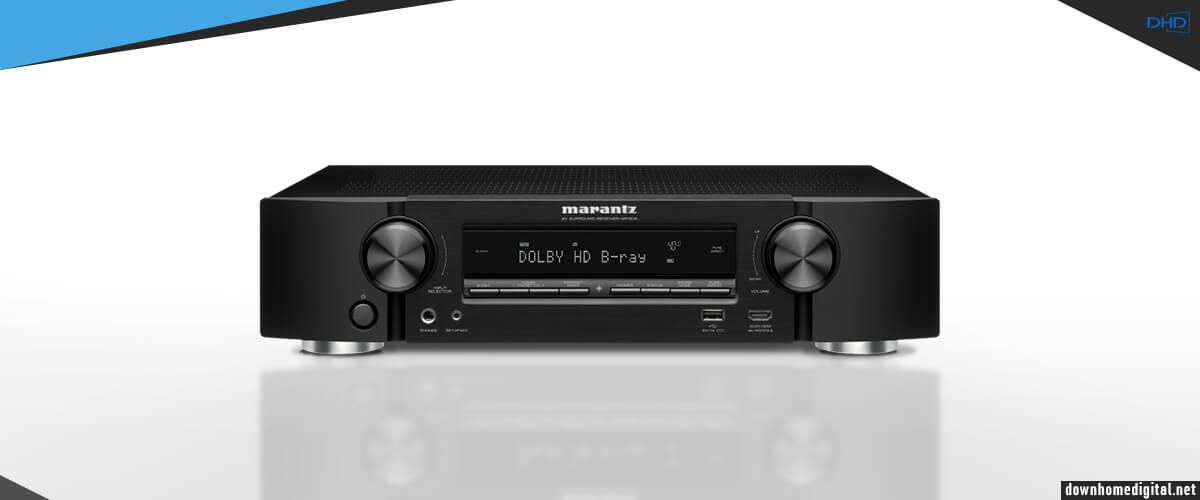
Marantz NR1510 is a 5-channel model with a low-profile slim body. This form factor works well with modern flat-panel TVs. It should be noted that this is the only receiver with a minimum number of channels for surround sound in the brand’s range, and despite the 2019 release year, the manufacturer has not yet released an alternative to it. It is popular among users because it combines miniature dimensions with sufficient functionality and just a chic budget yen for equipment of such a level as Marantz, the leader among brands of receivers for home theaters.
To date, this slim little guy is the only owner of a normal-sized LCD from Marantz, which pleased me. Well, since the receiver is a budget receiver, I thoroughly checked every button and regulator. Well, I can say that it is significantly different from any other cheap receiver from another brand. The build quality of the NR1510 can be compared to the mid-range segment, no less. However, you must remember that you should expect some nuances at 17.3 x 14.9 x 4.1 inches and weighing 18.1 pounds. In thin devices, the internal components are very close together, creating electronic interference, even with the Marantz. This is the reason for the AVR’s lowest power rating in my ranking. At higher settings, the receiver would overheat too much, producing interference at low volume. In general, NR1510 is not designed for heavy loads, so it will be suitable for small rooms. But for 5-channel systems, it is a standard. I found the remote control too big, and the buttons are located inconveniently.

The device is compatible with HEOS wireless multi-room technology and can be easily integrated into such an ecosystem as a hub. You can control your HEOS system using an app installed on a tablet or phone. Besides, the unit comes with an integrated Amazon Alexa voice assistant for fast and effortless adjustments.
Five discrete amplifiers are equipped with high-current transistors that deliver 50 watts per channel at 8 Ohms (60 W/6 ohms). For wireless streaming, you can use Wi-Fi, Bluetooth, and AirPlay. The receiver plays files in Hi-Res format (including DSD 5.6 MHz) placed on servers and computers on the local network. There is also direct access to such online services as Spotify, TuneIn, Deezer, and more.
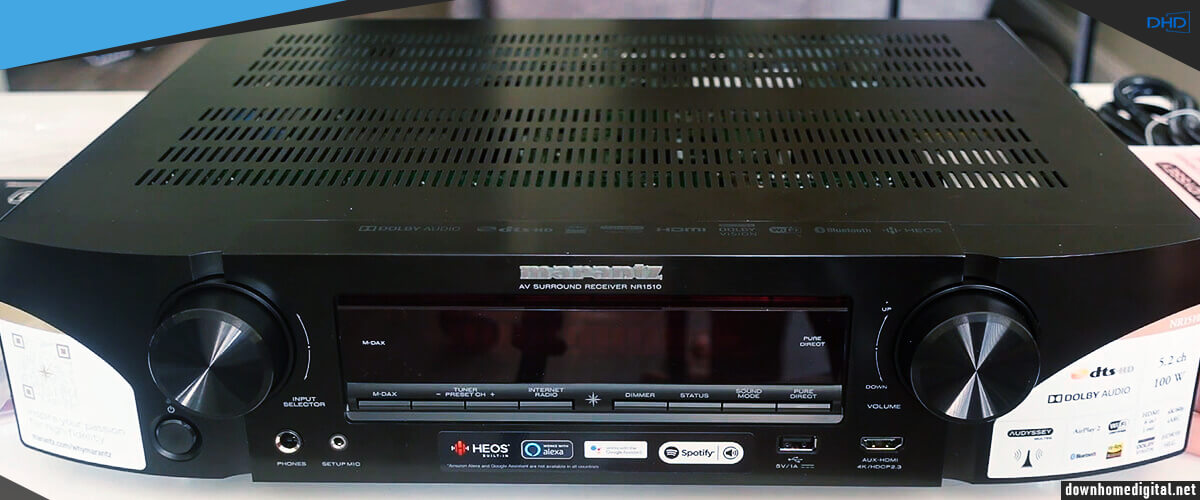
When I connected speakers to this receiver, I fully relied on the Audyssey MultEQ system, Dynamic EQ technologies, and Dynamic Volume. As a result, the sound was accurate both at low and high frequencies. With surround sound in the standard basic DTS HD Master and Dolby TrueHD modes, I observed exceptional channel separation and crisp and clean sound. Soundtracks don’t blend in with dialog when watching movies, and the dynamic volume works well. Sure, the soundstage doesn’t compare to larger systems, but the sound surrounds you from all sides, and the signal quality is way better than identical receivers in other brands. However, you’ll only have access to video at 4K resolution.
I can totally understand why you might be looking for a low-profile receiver, but you have to be willing to compromise with it, even when it comes to a brand that is considered the most premium. The NR1510 can’t compare to any AVRs described in the review. You can expect very low power due to the specific design, limited equipment connections, video with only 4K resolution, unstable antiresonance (because of the weight), and possible overheating. But there is a decent explanation for all this. In addition, you will not be mistaken in the quality advantages of the manufacturer itself.
NR1510 is the best budget Marantz home theater receiver, for which the brand has not yet released a replacement, although it has produced the model since 2019. This baby will suit a small room, perhaps a bedroom or a nursery, and give you a great surround sound, much better than similar devices in other brands.
| Power |
|
| HDMI features |
|
| Video features |
|
| Network |
|
| Surround sound processing |
|
| Channels | 5.2 |
| Stereo power (RMS), W/Ohm | 50/8, 60/6 |
| Output impedance, Ohm | 8, 6 |
| Frequency response | 10Hz-100KHz |
| THD in stereo, % | 0.08 |
| Digital to analog converter (DAC) | 192 KHz/32-bit |
| Bi-amping | no |
| Pure direct (straight) | yes |
| Auto speaker calibration | Audyssey MultEQ |
| Speaker A/B switching | no |
| Other audio features | Audyssey Dynamic Volume, Audyssey Dynamic EQ, Compressed Audio Enhancer, Hi-Res audio |
| Wi-Fi | 2.4/5GHz |
| USB | 1 (USB 2.0) |
| Bluetooth | yes |
| Ethernet (RJ45) | 1 |
| DLNA | no |
| MHL | no |
| Apple Music (AirPlay) | AirPlay, AirPlay 2 |
| Amazon Music | yes |
| Spotify | yes |
| Other streaming services | Deezer, TIDAL, Pandora, Napster, SiriusXM, TuneIn Radio |
| HDMI input/output | 8/1 |
| HDMI ARC (Audio Return Channel) | yes |
| HDMI eARC (Enhanced Audio Return Channel) | yes |
| HDMI CEC | yes |
| Digital content protection (HDCP) | HDCP 2.3 |
| Subwoofer output (LFE) | 2 |
| Headphone output | 1 x 6.3 |
| Optical digital input | 1 |
| Coaxial digital input | 1 |
| Composite input | 3 |
| Component input/output | 2/1 |
| Phono (MM) input | yes |
| Front panel connectors | USB, HDMI, phones, setup mic |
| Multi channel preamp output | yes |
| HDR (High Dynamic Range) | HDR10 |
| 4K signal pass-through | 4K/60Hz |
| 8K signal pass-through | no |
| HDMI signal pass-through | yes |
| 3D signal pass-through | yes |
| HDMI pass-through in standby mode | yes |
| Video conversion | no |
| Analog to HDMI scaling | no |
| HDMI to HDMI scaling | no |
| Dolby Vision | yes |
| Other video features | HLG, BT.2020 |
| Voice control | Amazon Alexa, Google Assistant, Siri, Josh.AI |
| App control | iPhone, iPad, iPod, Android, Amazon Kindle |
| Display | colour OSD |
| Tuner | AM, FM |
| Sleep timer | yes |
| Auto power off | yes |
| ECO mode | yes |
| Graphical user interface (GUI) | yes |
| Setup assistant | yes |
| Firmware update | network, USB |
| Other additional features | IP Control, Web Control |
| Multi-room zones | has not |
| Zone audio output | has not |
| Zone HDMI output | has not |
| Multi-room control | has not |
| RS-232 | 0 |
| Remote control input/output (IR) | 1/0 |
| DC trigger output (12V) | 1 |
| Dolby Atmos | no |
| Dolby TrueHD | yes |
| Dolby Surround | no |
| Dolby (other) | Dolby Digital Plus |
| DTS:X | no |
| DTS HD Master | yes |
| DTS Virtual:X | no |
| DTS Neural:X | no |
| DTS (other) | DTS-ES, DTS 96/24, DTS-HD, DTS-EXPRESS, DTS-Surround, DTS-Neo:6 |
| Auro-3D | no |
| IMAX Enhanced | no |
| Multichannel stereo | yes |
| MP3 | yes |
| WMA | yes |
| AAC | yes |
| WAV | yes |
| FLAC | yes |
| ALAC | yes |
| Other audio file formats | has not |
| Operational power consumption, W | 180 |
| Standby consumption, W | 0.2 |
| Removable power cord | yes |
| Size W x H x D, cm/inches | 43.5 x 10.1 x 35.5/17 x 4.1 x 14.9 |
| Weight, kg/lbs | 8.1/18.1 |
| Release year | 2019 |
Pros
- Excellent low-profile design is comfortable.
- Exceptional channel separation, crisp and clear sound.
- Soundtracks do not merge with dialog when watching movies.
- Dynamic volume works perfectly.
Cons
- The least powerful receiver of the selection.
- May overheat with prolonged use.
- The receiver can not be overloaded; otherwise, it will overheat.
- The remote control is too big, and the buttons are inconveniently placed.
- 4K video only.
Marantz NR1200 – stereo
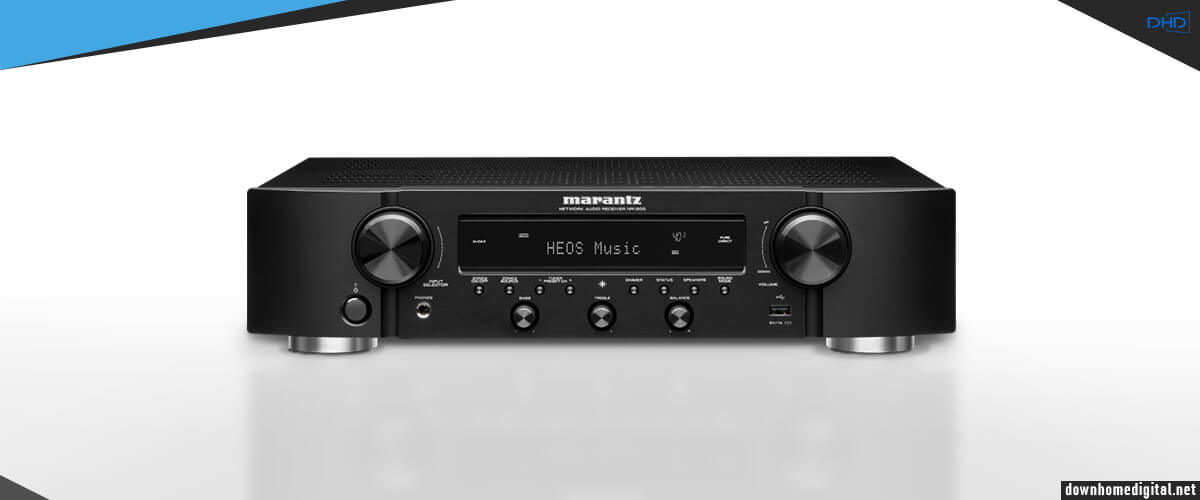
The model has a slim form factor, which is typical for all representatives of the NR series. However, in its case, we are dealing with a stereo device (2 channels only), focused primarily on music lovers. Most of the sound path is designed in the “dual mono” concept. Working with soundtracks in movies, the NR1200 automatically down-mixes all surround formats to stereo. That happened when I watched the movie, but I can’t say that the sound quality was severely degraded.
Externally, the NR1200 looks very similar to the NR1510 and has the same dimensions and weight. The build quality is also identical, and you will have the same “problems” with overheating due to the close location of components inside the chassis. And taking into account the higher power of the model in question, you should be especially careful about overheating. The receiver tolerates loads better (after all, it has only two amplifiers), but the device sometimes switches off arbitrarily, apparently fleeing from high temperatures. I would like to mention separate controls for bass, treble, and balance, but they are all small buttons, not the most convenient, in my opinion.
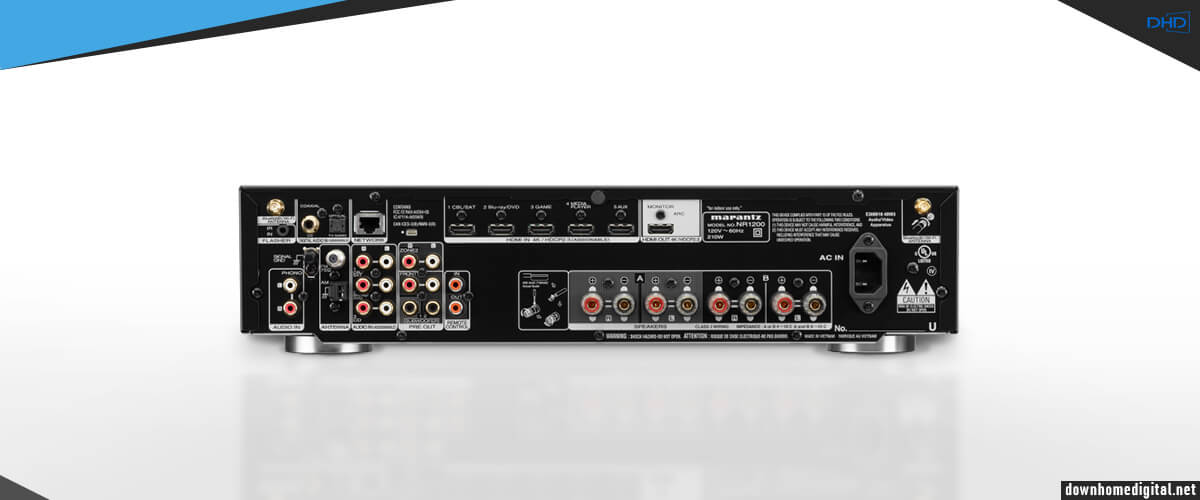
The cutie has five HDMI inputs, which can be automatically renamed based on information provided by connected sources. Each of the inputs supports all current standards, including HDCP 2.3 copy protection technology, 4K Ultra HD 60 Hz video, and more. The power output is 75W at 8 Ohms, and 100W at 6 Ohms.
The NR1200 has built-in HEOS functionality, giving you access to online services like Spotify, Amazon Music, Tidal, TuneIn internet radio, and more. In addition, you can take advantage of multi-room based on HEOS. Everything works stably, but the volume control from Apple devices is disappointing as it dials in slowly, and I ended up not getting a decent result.
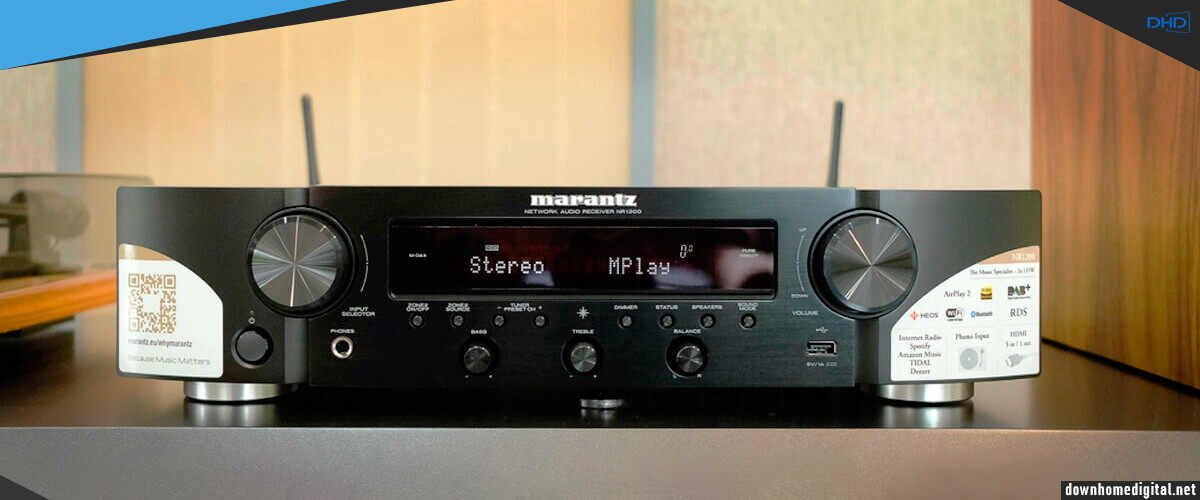
Connecting the receiver to a music system and setting it up is extremely simple. Once you set a wireless connection and install the HEOS app, you need to choose a signal source (Internet radio, streaming service, or files on the server). Remember the Pure Direct mode, in which all unnecessary circuits are turned off, including the display and video signal output via HDMI. So, I recommend turning this mode on when listening to the audio, as the difference in sound quality is dramatic.
The special warm timbre of the Marantz is ideal for rock, acoustic, vocals, jazz, and other genres. That’s why the phono input is extremely appropriate here; I was pleased with the phono preamplifier built into the receiver. Of course, an external preamplifier is always better, but this is it if you are not an audiophile but a vinyl fan. For streaming music, the NR1200 is awesome (especially considering its price). I’d call the balance between old-school stereo receivers and modern wireless streaming devices perfect for a receiver at this level. But track numbers are sometimes deleted, so playing an album becomes a mind teaser.
Stereo receivers are gaining popularity, as many people can live without surround sound. With its slim, comfortable design, affordable price, unrivaled quality, HDMI ports, and built-in wireless options, I can safely call the NR1200 the best-sounding Marantz receiver among current 2-channel units. It delivers superb sound, can work with various speakers, and is absolutely easy to operate. Even its power is superior to the 5-channel NR1510. But if you’re still dreaming of watching movies in your home with surround sound, check out the other models in this selection, including discontinued models.
| Power |
|
| HDMI features |
|
| Video features |
|
| Network |
|
| Surround sound processing |
|
| Channels | 2.0 |
| Stereo power (RMS), W/Ohm | 75/8, 100/6 |
| Output impedance, Ohm | 8, 6 |
| Frequency response | 10Hz-100KHz |
| THD in stereo, % | 0.08 |
| Digital to analog converter (DAC) | 192 KHz/32-bit |
| Bi-amping | no |
| Pure direct (straight) | yes |
| Auto speaker calibration | no |
| Speaker A/B switching | no |
| Other audio features | Hi-Res audio |
| Wi-Fi | 2.4/5GHz |
| USB | 1 (USB 2.0) |
| Bluetooth | yes |
| Ethernet (RJ45) | 1 |
| DLNA | no |
| MHL | no |
| Apple Music (AirPlay) | AirPlay, AirPlay 2 |
| Amazon Music | yes |
| Spotify | yes |
| Other streaming services | Deezer, TIDAL, Pandora, Napster, SiriusXM, TuneIn Radio |
| HDMI input/output | 5/1 |
| HDMI ARC (Audio Return Channel) | yes |
| HDMI eARC (Enhanced Audio Return Channel) | no |
| HDMI CEC | yes |
| Digital content protection (HDCP) | HDCP 2.3 |
| Subwoofer output (LFE) | 2 |
| Headphone output | 1 x 6.3 |
| Optical digital input | 1 |
| Coaxial digital input | 1 |
| Composite input | 0 |
| Component input/output | 0/0 |
| Phono (MM) input | yes |
| Front panel connectors | USB, phones |
| Multi channel preamp output | no |
| HDR (High Dynamic Range) | HDR10 |
| 4K signal pass-through | 4K/60Hz |
| 8K signal pass-through | no |
| HDMI signal pass-through | yes |
| 3D signal pass-through | yes |
| HDMI pass-through in standby mode | yes |
| Video conversion | no |
| Analog to HDMI scaling | no |
| HDMI to HDMI scaling | no |
| Dolby Vision | no |
| Other video features | HLG |
| Voice control | Amazon Alexa, Google Assistant, Siri, Josh.AI |
| App control | iPhone, iPad, iPod, Android, Amazon Kindle |
| Display | colour OSD |
| Tuner | AM, FM |
| Sleep timer | yes |
| Auto power off | yes |
| ECO mode | yes |
| Graphical user interface (GUI) | yes |
| Setup assistant | yes |
| Firmware update | network, USB |
| Other additional features | IP Control, Web Control |
| Multi-room zones | has not |
| Zone audio output | has not |
| Zone HDMI output | has not |
| Multi-room control | has not |
| RS-232 | 0 |
| Remote control input/output (IR) | 0/0 |
| DC trigger output (12V) | 0 |
| Dolby Atmos | no |
| Dolby TrueHD | no |
| Dolby Surround | no |
| Dolby (other) | has not |
| DTS:X | no |
| DTS HD Master | no |
| DTS Virtual:X | no |
| DTS Neural:X | no |
| DTS (other) | has not |
| Auro-3D | no |
| IMAX Enhanced | no |
| Multichannel stereo | no |
| MP3 | yes |
| WMA | yes |
| AAC | yes |
| WAV | yes |
| FLAC | yes |
| ALAC | yes |
| Other audio file formats | has not |
| Operational power consumption, W | 180 |
| Standby consumption, W | 0.2 |
| Removable power cord | yes |
| Size W x H x D, cm/inches | 43.5 x 10.1 x 35.5/17 x 4.1 x 14.9 |
| Weight, kg/lbs | 8.1/18.1 |
| Release year | 2019 |
Pros
- Hybrid stereo receiver with 4K video streaming capability.
- Stunning sound in rock, acoustic, vocals, jazz, and other genres.
Cons
- It can randomly turn off when heated.
- Volume control from Apple devices is disappointing.
- Track numbers are sometimes deleted, so album playback becomes a mind teaser.
Buyer’s guide

What to look for when choosing a receiver
Amplifier channels
Simply put, the number of channels in an AV receiver defines how many speakers it can power. For instance, if you have a home theater receiver with 5 channels, it means you can connect 5 speakers.
Sometimes, you may see 2 numbers separated with a dot. The second figure, in this case, determines that you can attach a subwoofer (or even 2).
The majority of A/V receivers are 5.1 and 7.1 units. Such a configuration is sufficient for most users, though some buyers opt for larger setups. Not to go overboard, you need to choose the number of channels based on the size of your room. A 5.1 device is perfectly suitable for a medium-sized room, while a 7.1 model is a great option for larger spaces.
However, if you plan to relocate your system to a bigger place, it may be a reasonable decision to get a receiver with more channels, but for a particular time, use only basic speakers. Once the upgrade is needed, you can connect the rest of the speakers without investing in a new product.
Receiver power
All receivers emit power that is measured in watts. This power is like fuel for a device needed to perform its functions. Of course, some receivers are more powerful, but it doesn’t mean that they are the only purchase-worthy options. In fact, you need to clearly understand how powerful a receiver you need for your room.
For a wonder, manufacturers indicate the power output for a receiver measured only for 2 active channels. This is really strange, especially if you want to connect 5 or more receivers, but can’t learn how much power a receiver will put out. Fortunately, it isn’t such a crucial parameter.
The good news is that most modern receivers can easily power any home theater system without scarifying sound quality. That’s possible thanks to modern technological innovations. A good rule of thumb is to choose a receiver with the lowest power rating suitable for your room.
Built-in Wi-Fi, Bluetooth, and streaming services
Nowadays, AV receivers come with different types of wireless connections. In the case of budget-friendly models, this can be just one wireless connection method – Bluetooth or Wi-Fi. Having the possibility to connect external devices to your receiver without dealing with cords is definitely a pleasure. Another advantage is that you can stream music from various sources using just your phone or tablet.
Receivers with advanced music features also offer a multi-zone option, which is extremely popular among large families. If you have such a receiver, you can spend time in one room listening to your favorite music while your children in another room will watch their cartoons.
However, if a multi-room feature is a decisive point for you, think twice. The main pitfall here is that many receivers fail to transmit signals across several rooms properly being subject to various interferences. Moreover, to power several sets of speakers scattered across a house, you need to arrange many long cables to connect speakers. That isn’t a space-saving decision.
What kinds of inputs and outputs do you need
Typically, receivers have several HDMI inputs and outputs on the rear and front panels. This is the most widespread port for connecting a Blu-ray player, consoles, and a TV. However, more sophisticated receivers have a larger set of HDMI inputs and outputs, and while this sounds cool, such a goodie comes at an additional cost. I believe a regular range of HDMI ports (usually 4) is enough for most needs. Of course, if you plan to connect lots of accessories or want to cover your future upgrades, you need more, but don’t get too carried away with this matter.
Other common connections are audio inputs (both digital and analog). These are needed for connecting CD/DVD players, media centers, tuners, etc. If you are going to attach something like that, make sure to buy a proper receiver.
Digital inputs are more secure because signals transmitted via them don’t suffer from electrical interferences, unlike analog signals. The main thing here is to ensure digital inputs can process surround-sound formats if you want to get amazing sound quality. Digital audio connections can be of 2 kinds – coaxial and optical. Some audiophiles think that the first type delivers better sound, but average users won’t hear serious quality drops.
If there is no possibility to use digital inputs, you can take advantage of analog ports. They are suitable for connecting analog VCRs, cassette recorders, older game consoles, and radio tuners.
Discontinued models
This section lists two 2020 receivers that have been replaced by the more advanced and balanced Marantz CINEMA 50. Nevertheless, they are quite up-to-date if you are not fussy about details. Those looking to save a bit of money should be interested. Or you’ll still see why overpaying a couple hundred bucks for a newer model is worth it. Either way, it’s worth it.
Marantz SR6015
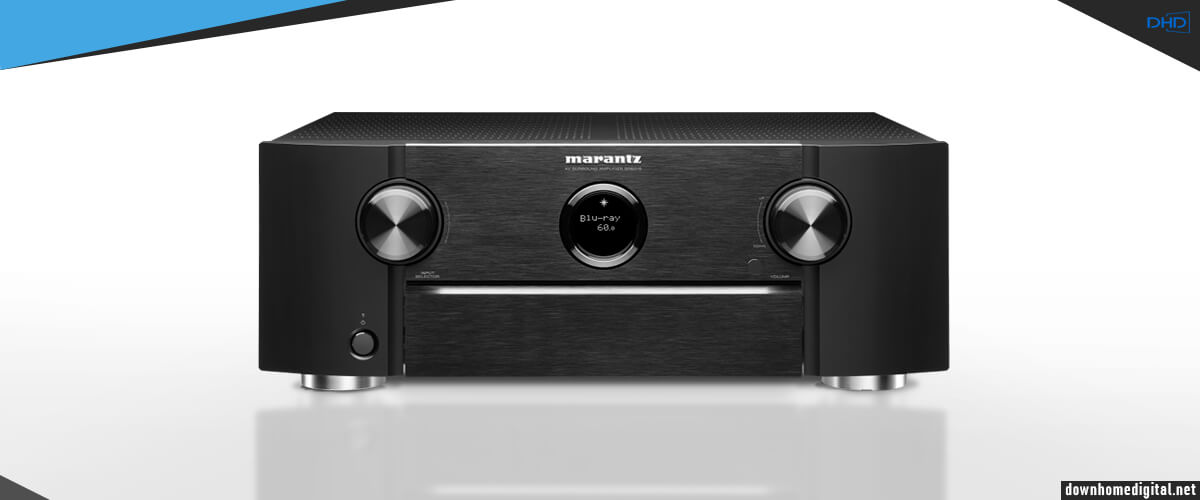
The manufacturer released this model after evaluating the weak points of the Marantz SR6014 (the forerunner). It is bound to satisfy users seeking the most robust AV receiver capable of delivering high-quality sound in large rooms. Being initially designed as a 9-channel unit, it has enough power for future upgrades if you plan to jump to an 11-channel system. Thus, the model can easily compete with a much-hyped Marantz SR8015, which initially has 11 channels.
The first thing that caught my eye was the update in the HDMI ports, so now you can watch 8K content. But only 1 input is equipped with version 2.1. Another pleasant feature is support for Dolby Atmos and DTS:X. I understand why Marantz pays so much attention to modern decoding standards, as this is actually one of the most important characteristics buyers check out while selecting a new AV receiver. IMAX Enhanced is another option to provide outstanding video and audio quality.
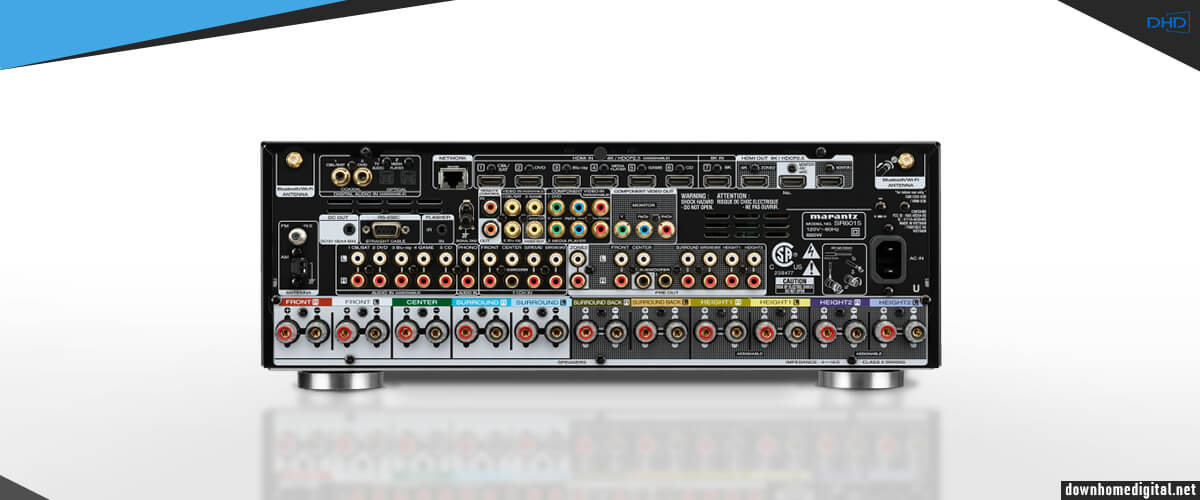
Marantz SR6015 has 7 HDMI inputs and 3 outputs, which is more than enough for connecting all types of video & audio sources. Besides, you can use a wireless connection. I easily connected all my equipment, and there were enough ports for other devices. While watching the movie, I liked that the background sound didn’t interfere with the dialogs, which is a frequent problem with same-priced receivers from other brands. Thanks to Quick Frame Transport and ALLM technologies, I experienced no lags. By the way, these features are used to optimize the image in games, but I am not a gamer, so I didn’t test them.
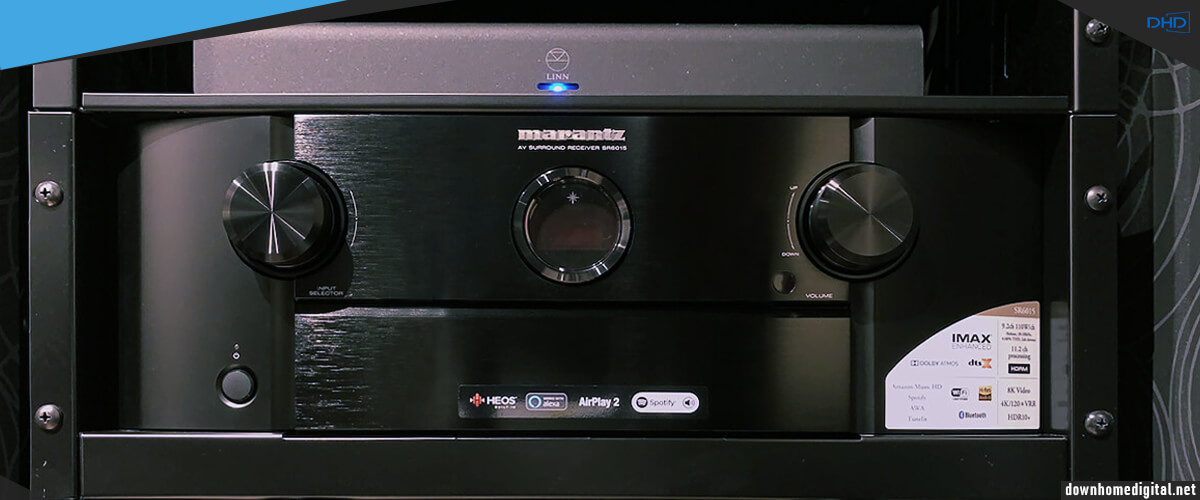
The declared power output is 110 watts/8 Ohm and 150 watts with 6 Ohms speakers. I think this is enough for the majority of tasks. While streaming audio from multiple sources, I liked how hassle-free this process was. As for audio quality, everything is awesome.
To my mind, the SR6015 is the great Marantz receiver, although it is a bit of a departure from more modern models. Being packed with all the needed features, it also incorporates many cool bonuses for music connoisseurs and avid movie lovers. It is powerful enough to cover large spaces, allowing you to adjust sound based on your needs.
| Power |
|
| HDMI features |
|
| Video features |
|
| Network |
|
| Surround sound processing |
|
| Channels | 9.2 |
| Stereo power (RMS), W/Ohm | 110/8, 150/6 |
| Output impedance, Ohm | 8, 6 |
| Frequency response | 10Hz-100KHz |
| THD in stereo, % | 0.08 |
| Digital to analog converter (DAC) | N/A |
| Bi-amping | yes |
| Pure direct (straight) | yes |
| Auto speaker calibration | Audyssey MultEQ XT32 |
| Speaker A/B switching | yes |
| Other audio features | Audyssey Dynamic Volume, Audyssey Dynamic EQ, Audyssey LF, Compressed Audio Enhancer(MDAX2), Hi-Res audio |
| Wi-Fi | 2.4/5GHz |
| USB | 1 (USB 2.0) |
| Bluetooth | yes |
| Ethernet (RJ45) | 1 |
| DLNA | yes |
| MHL | no |
| Apple Music (AirPlay) | AirPlay, AirPlay 2 |
| Amazon Music | yes |
| Spotify | yes |
| Other streaming services | Deezer, TIDAL, Pandora, SiriusXM, Napster, SoundCloud |
| HDMI input/output | 7/3 |
| HDMI ARC (Audio Return Channel) | yes |
| HDMI eARC (Enhanced Audio Return Channel) | yes |
| HDMI CEC | yes |
| Digital content protection (HDCP) | HDCP 2.3 |
| Subwoofer output (LFE) | 2 |
| Headphone output | 1 x 6.3 |
| Optical digital input | 2 |
| Coaxial digital input | 2 |
| Composite input | 4 |
| Component input/output | 2/1 |
| Phono (MM) input | yes |
| Front panel connectors | USB, phones, setup mic, AUX |
| Multi channel preamp output | yes |
| HDR (High Dynamic Range) | HDR10 |
| 4K signal pass-through | 4K/120Hz |
| 8K signal pass-through | 8K/60Hz |
| HDMI signal pass-through | yes |
| 3D signal pass-through | yes |
| HDMI pass-through in standby mode | yes |
| Video conversion | analog to HDMI |
| Analog to HDMI scaling | yes |
| HDMI to HDMI scaling | yes |
| Dolby Vision | yes |
| Other video features | HLG, BT.2020, Dynamic HDR |
| Voice control | Amazon Alexa, Google Assistant, Siri, Josh.AI |
| App control | iPhone, iPad, iPod, Android |
| Display | colour OSD |
| Tuner | AM, FM |
| Sleep timer | yes |
| Auto power off | yes |
| ECO mode | yes |
| Graphical user interface (GUI) | yes |
| Setup assistant | yes |
| Firmware update | network, USB |
| Other additional features | IP Control, Web Control, RS-232 Control, App Control |
| Multi-room zones | 2 |
| Zone audio output | speaker, preout |
| Zone HDMI output | yes |
| Multi-room control | Marantz 2016 AVR Remote, HEOS App |
| RS-232 | 1 |
| Remote control input/output (IR) | 1/0 |
| DC trigger output (12V) | 1 |
| Dolby Atmos | yes |
| Dolby TrueHD | yes |
| Dolby Surround | yes |
| Dolby (other) | Dolby Digital Plus, Dolby Atmos Height Virtualization |
| DTS:X | yes |
| DTS HD Master | yes |
| DTS Virtual:X | yes |
| DTS Neural:X | yes |
| DTS (other) | DTS 96/24, DTS-HD, DTS-EXPRESS |
| Auro-3D | no |
| IMAX Enhanced | yes |
| Multichannel stereo | yes |
| MP3 | yes |
| WMA | yes |
| AAC | yes |
| WAV | yes |
| FLAC | yes |
| ALAC | yes |
| Other audio file formats | AIFF, DSD |
| Operational power consumption, W | 680 |
| Standby consumption, W | 0.2 |
| Removable power cord | yes |
| Size W x H x D, cm/inches | 43.1 x 15.2 x 38.1/17.3 x 6.3 x 15.3 |
| Weight, kg/lbs | 12.7/28.2 |
| Release year | 2020 |
Pros
- The amplifiers in the AV receiver are discrete components and provide significant output current, making it easy to handle even complex acoustics.
- Supports popular voice assistants Amazon Alexa, Google Assistant and Apple Siri.
- The receiver’s main HDMI output supports the extended audio return channel eARC for any soundtrack.
- Dolby Atmos, DTS:X and IMAX Enhanced support.
Cons
- No SONOS connectivity.
- Room correction setup is very time-consuming.
- Only 1 HDMI input supports 8K video.
Marantz SR7015
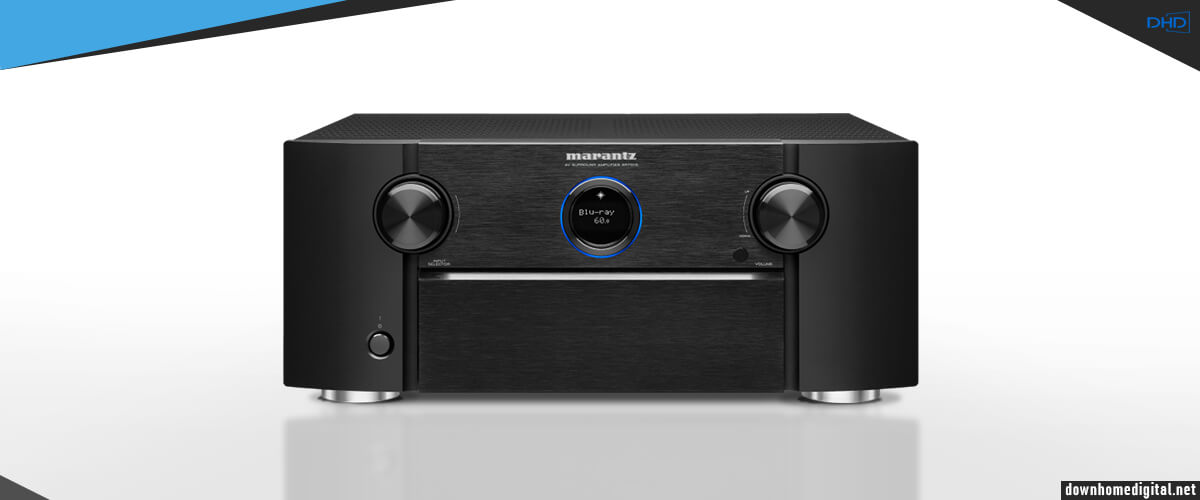
When I saw this unit, I immediately understood that it belonged to the Marantz lineup. It has a classic design with matte curved sides, a metal front panel, and a shiny center. This 9-channel model comes with an impressive array of inputs, but I think some of them are needless. For example, there are too many analog and digital audio inputs, and I even found a dated component and composite video.
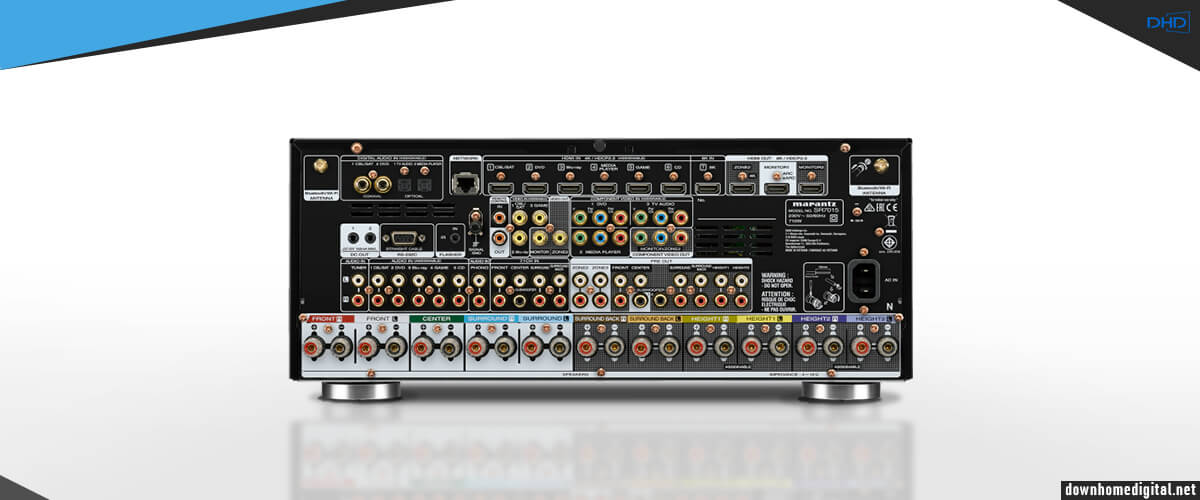
On the other hand, there is an MM-phono input, which will appeal to owners of turntables. The AV amplifier has eight HDMI inputs (seven at the rear and one at the front) and three HDMI outputs. One of the HDMI inputs and two HDMI outputs support 8K/60Hz and 4K/120Hz video (up to 40Gbps), and the main HDMI output also supports eARC. The power output is 125 watts at 8 Ohms and 165 watts at 6 Ohms.
Setting up the receiver for the first time was pretty easy, thanks to the Setup Assistant. It guided me through the entire process step by step. Setup Assistant offers simple, clear, and concise instructions. It covers everything from choosing speaker layouts to setting up various inputs and outputs and various additional functions.

Marantz SR7015 delivers great sound in different conditions. I appreciate the significant headroom, which ensures amazing sounding even when all channels are actively used. Thus, you get a wide dynamic range and rich, sweeping sound without feeling that Marantz SR7015 is about to die. The sound was fast and agile, with an accurate transient response and complete acoustics control. That’s how a top-notch surround sound receiver should work. It reminded me of Marantz SR8015 when I listened to action-packed compositions, but in this case, the sound was softer.
Marantz SR7015 is an impressive AV receiver that has all the key features. There are a variety of inputs, and it has a signature Marantz design as well as superb build quality. Perhaps, more importantly, is that the SR7015 sounds fantastic, precise, and musical, as we usually expect from Marantz.
| Power |
|
| HDMI features |
|
| Video features |
|
| Network |
|
| Surround sound processing |
|
| Channels | 9.2 |
| Stereo power (RMS), W/Ohm | 125/8, 165/6 |
| Output impedance, Ohm | 8, 6 |
| Frequency response | 10Hz-100KHz |
| THD in stereo, % | 0.05 |
| Digital to analog converter (DAC) | N/A |
| Bi-amping | yes |
| Pure direct (straight) | yes |
| Auto speaker calibration | Audyssey MultEQ XT32 |
| Speaker A/B switching | yes |
| Other audio features | Audyssey Dynamic Volume, Audyssey Dynamic EQ, Audyssey LF, Compressed Audio Enhancer(MDAX2), Hi-Res audio |
| Wi-Fi | 2.4/5GHz |
| USB | 1 (USB 2.0) |
| Bluetooth | yes |
| Ethernet (RJ45) | 1 |
| DLNA | yes |
| MHL | no |
| Apple Music (AirPlay) | AirPlay, AirPlay 2 |
| Amazon Music | yes |
| Spotify | yes |
| Other streaming services | Deezer, TIDAL, Pandora, SiriusXM, Napster, SoundCloud |
| HDMI input/output | 8/3 |
| HDMI ARC (Audio Return Channel) | yes |
| HDMI eARC (Enhanced Audio Return Channel) | yes |
| HDMI CEC | yes |
| Digital content protection (HDCP) | HDCP 2.3 |
| Subwoofer output (LFE) | 2 |
| Headphone output | 1 x 6.3 |
| Optical digital input | 2 |
| Coaxial digital input | 2 |
| Composite input | 4 |
| Component input/output | 3/1 |
| Phono (MM) input | yes |
| Front panel connectors | USB, HDMI, phones, setup mic, AUX |
| Multi channel preamp output | yes |
| HDR (High Dynamic Range) | HDR10 |
| 4K signal pass-through | 4K/120Hz |
| 8K signal pass-through | 8K/60Hz |
| HDMI signal pass-through | yes |
| 3D signal pass-through | yes |
| HDMI pass-through in standby mode | yes |
| Video conversion | analog to HDMI |
| Analog to HDMI scaling | yes |
| HDMI to HDMI scaling | yes |
| Dolby Vision | yes |
| Other video features | HLG, BT.2020, Dynamic HDR |
| Voice control | Amazon Alexa, Google Assistant, Siri, Josh.AI |
| App control | iPhone, iPad, iPod, Android |
| Display | colour OSD |
| Tuner | AM, FM |
| Sleep timer | yes |
| Auto power off | yes |
| ECO mode | yes |
| Graphical user interface (GUI) | yes |
| Setup assistant | yes |
| Firmware update | network, USB |
| Other additional features | IP Control, Web Control, RS-232 Control, App Control |
| Multi-room zones | 3 |
| Zone audio output | speaker, preout |
| Zone HDMI output | yes |
| Multi-room control | Marantz 2016 AVR Remote, HEOS App |
| RS-232 | 1 |
| Remote control input/output (IR) | 1/0 |
| DC trigger output (12V) | 2 |
| Dolby Atmos | yes |
| Dolby TrueHD | yes |
| Dolby Surround | yes |
| Dolby (other) | Dolby Digital Plus, Dolby Atmos Height Virtualization |
| DTS:X | yes |
| DTS HD Master | yes |
| DTS Virtual:X | yes |
| DTS Neural:X | yes |
| DTS (other) | DTS 96/24, DTS-HD, DTS-EXPRESS |
| Auro-3D | yes |
| IMAX Enhanced | yes |
| Multichannel stereo | yes |
| MP3 | yes |
| WMA | yes |
| AAC | yes |
| WAV | yes |
| FLAC | yes |
| ALAC | yes |
| Other audio file formats | AIFF, DSD |
| Operational power consumption, W | 710 |
| Standby consumption, W | 0.1 |
| Removable power cord | yes |
| Size W x H x D, cm/inches | 43.1 x 17.8 x 38.1/17.3 x 7.3 x 15.8 |
| Weight, kg/lbs | 14/31.3 |
| Release year | 2020 |
Pros
- Warm and detailed sound with an extensive sound stage.
- Has 3D pass-through video on all HDMI inputs.
- Long-lasting design.
- Smooth compatibility with top-notch voice assistants.
Cons
- Lacks embedded tuner.
- Audyssey MultiEQ editing app has paid features.












